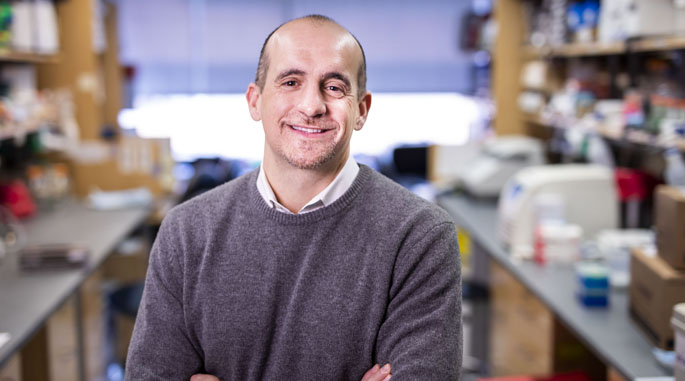
A comprehensive evaluation of the metabolic pathways that support Staphylococcus aureus (“staph”) growth during invasive bone infections, reported in the Proceedings of the National Academy of Sciences, could offer new targets for treatment.
“We’ve been able to uncover specific enzymes involved in metabolism that are particularly important for staph to survive in host tissues,” said Jim Cassat, MD, PhD, assistant professor of Pediatrics, Pathology, Microbiology and Immunology, and Biomedical Engineering at Vanderbilt. “We don’t know whether or not these enzymes are druggable, but they add to our toolkit to think about how we could potentially target bacterial metabolism to treat bone infections.”
S. aureus bacteria — particularly antibiotic-resistant forms — are a leading cause of hospital-acquired infections, infectious heart disease and pus-forming skin and soft tissue infections. Staph is also the most common cause of bone infection (osteomyelitis), which in adults typically follows a trauma or orthopaedic surgery.
Cassat, who is also an associate director of the Vanderbilt Institute for Infection, Immunology and Inflammation, got interested in osteomyelitis during his previous doctoral work and as a clinical fellow in Pediatric Infectious Diseases. He remembers being surprised at the number of “previously healthy children, sometimes with no risk factors, coming in with staph in their bone,” he said.
“Of all the places staph could end up — after it enters the bloodstream — what is it about bone that allows staph to thrive there?”
In previous studies, Cassat and his colleagues found that many of the genes that staph needs to survive in bone are metabolic genes. In the current study, they used bacterial mutants and a mouse infection model to fully explore “how staph gets the essential building blocks it needs to make more of itself,” Cassat said.
They discovered a series of genes that were required for staph survival in bone, but not for staph survival in the laboratory.
“We think our study is one of the most comprehensive analyses of the metabolic pathways that are required for invasive staph infection,” Cassat said.
The researchers were surprised to find that staph survival in bone depended on staph’s ability to synthesize the amino acid aspartate, even though it can acquire aspartate from the host. They identified a functional aspartate transporter and showed that it was inhibited by excess glutamate (another amino acid) in infected bone. Inhibition of the transporter likely forces staph to make its own aspartate.
“We tend to think about bacterial metabolism based on in vitro experiments or on what nutrients we think are present in healthy tissues,” Cassat said. “This study taught us that we have to think about how inflammation changes the levels of nutrients in the tissue, and how that might impact what staph needs to do to survive.”
Osteomyelitis often requires surgery to remove infected tissue, offering the possibility for the delivery of localized therapies, Cassat said. He and his colleagues hope to use their “basic research findings to understand and manipulate staph’s ability to grow in bone tissue.”
Aimee Potter, PhD, led the studies during her graduate work in Cassat’s laboratory. Other contributors include Casey Butrico, Caleb Ford, Jacob Curry, Irina Trenary, Srivarun Tummarakota, Andrew Hendrix, and Jamey Young, PhD.
The research was supported by the National Institutes of Health (grants AI132560, AI145992, AI113107, AI011254, AI133970, GM007347, AI138424, DK106348, CA235508) and by the Burroughs Wellcome Fund.












